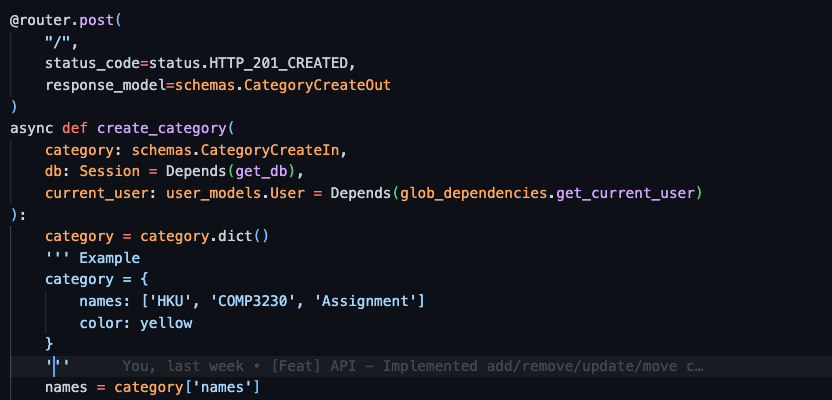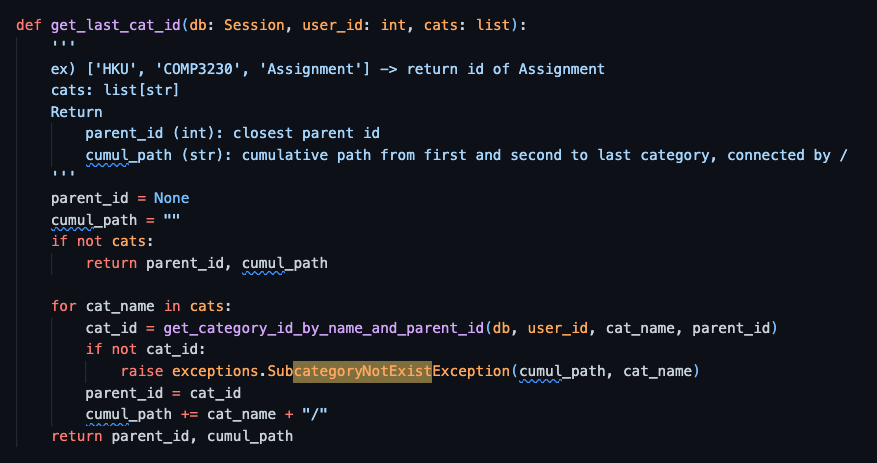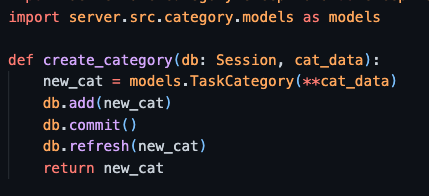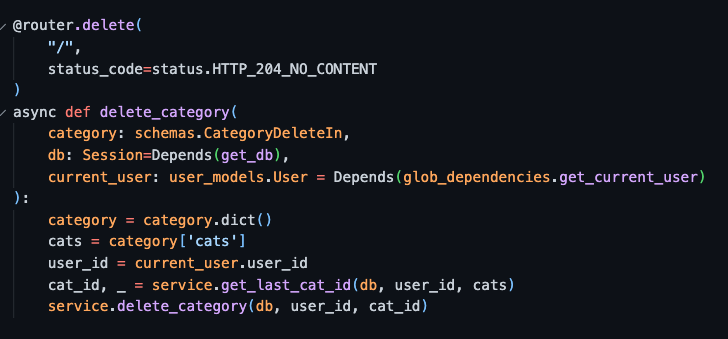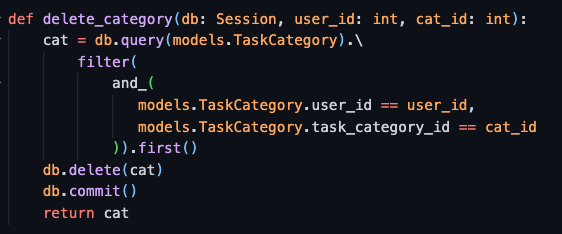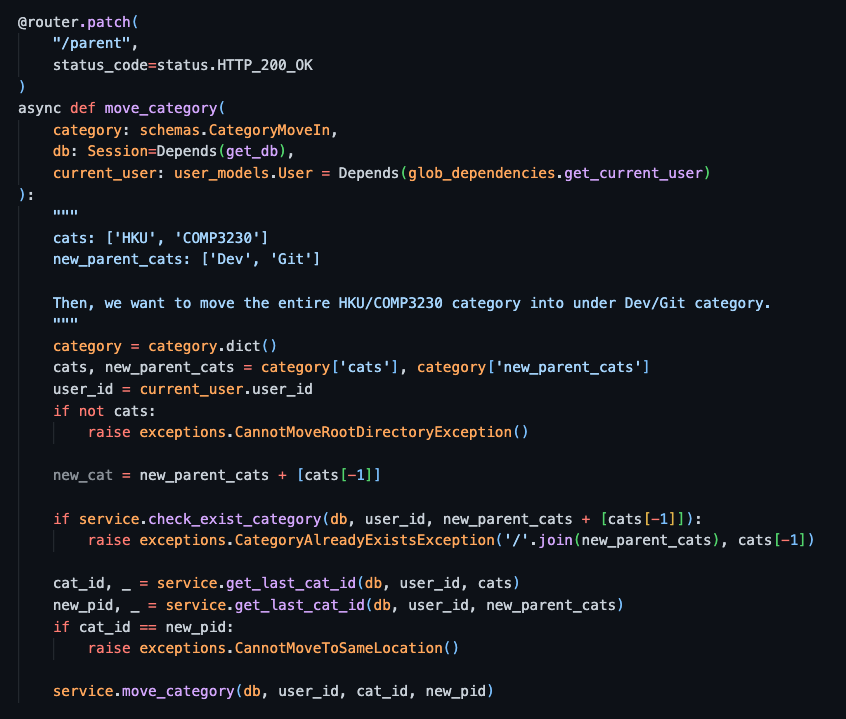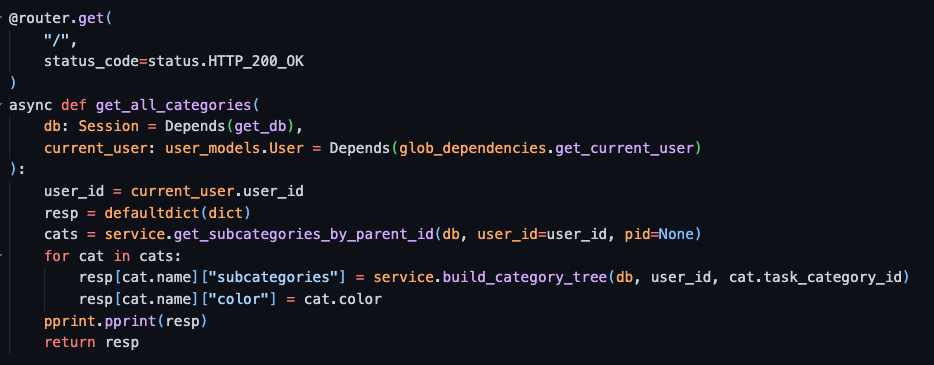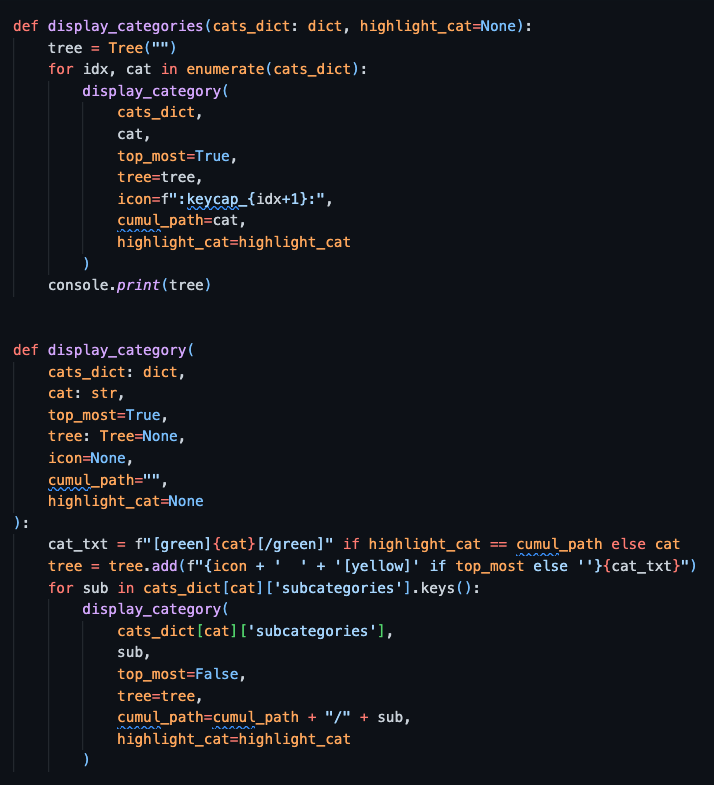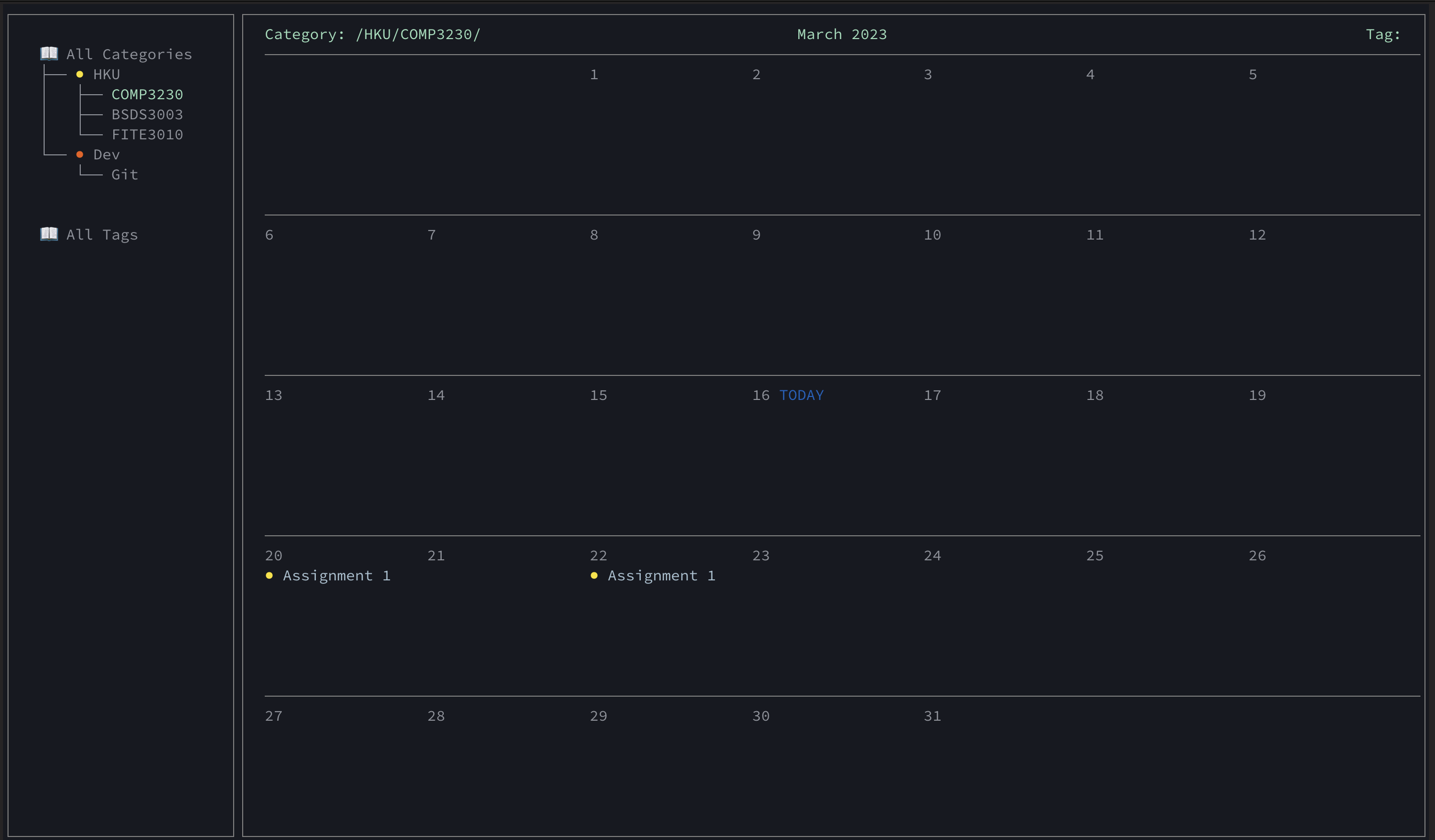- Introduction
- Show Category
- Add Category
- Remove Category
- Move Category
- Modeling self-referential relationship
- Visualize tree with Rich
Introduction
I’ve been working on a project recently to build a powerful schedule management app which saves users tremendous amount of time. It will offer a CLI (Command Line Interface) as well as Web app to quickly perform various schedule management operations.
Below is the CLI calendar view.
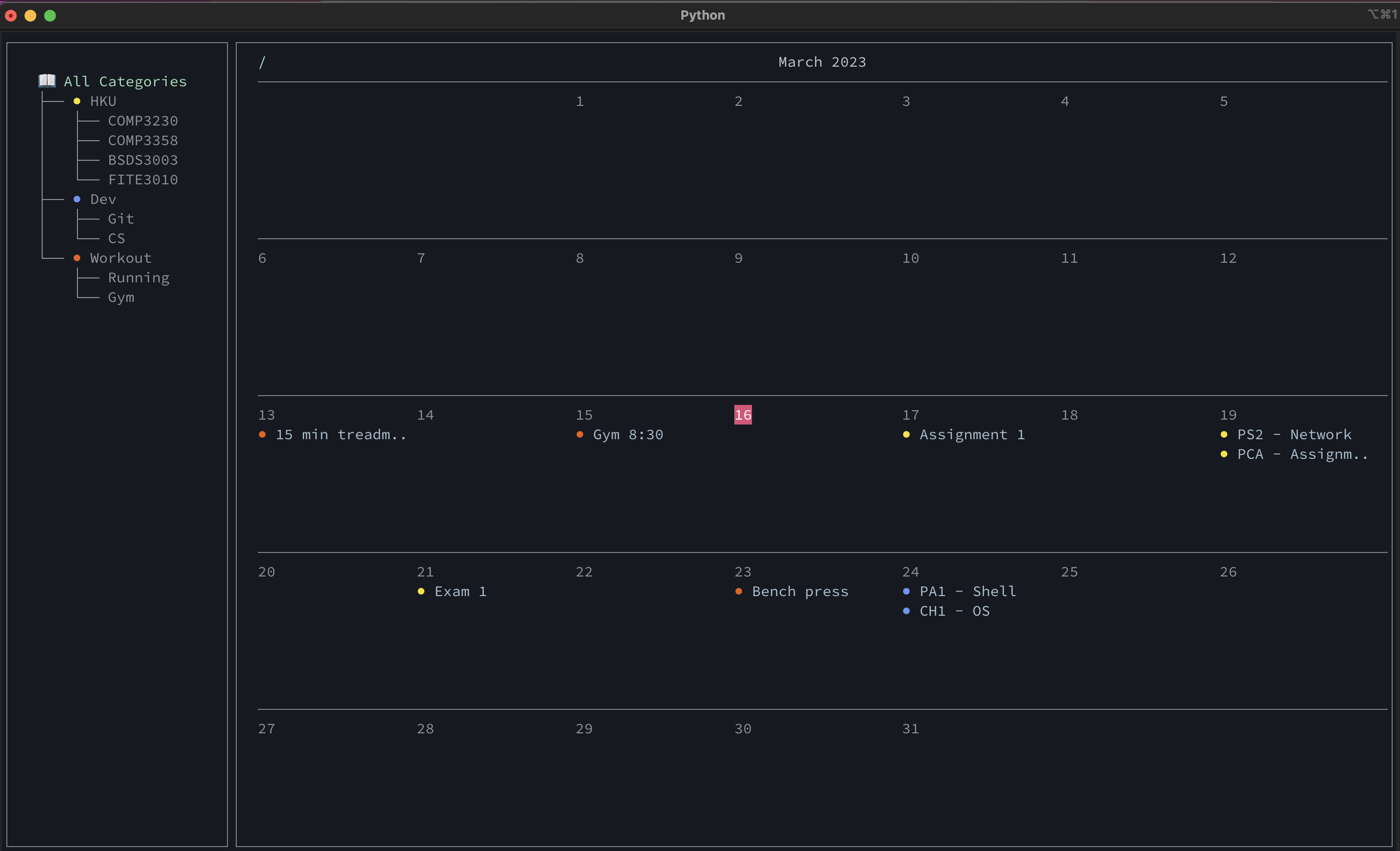 As you can see on the left side, one of the features supported is the infinite category tree. Users can pre-defined categories such as school work, life, workout that different tasks belong to. Some calendar apps offer the category feature but most of them don’t support infinite category tree.
As you can see on the left side, one of the features supported is the infinite category tree. Users can pre-defined categories such as school work, life, workout that different tasks belong to. Some calendar apps offer the category feature but most of them don’t support infinite category tree.
In this article, I’ll go through how to model the infinite category tree and how to perform different operations such as show, create, move, and remove categories.
Let’s first explore what you can learn after reading this article.
Show Categories
As you can see from the above, you can recursively create categories. For example, if you type showtask command, then it shows you the full category tree.
Add Categories
You could also add a category by a specifying a full path (parent path/ + new category name). 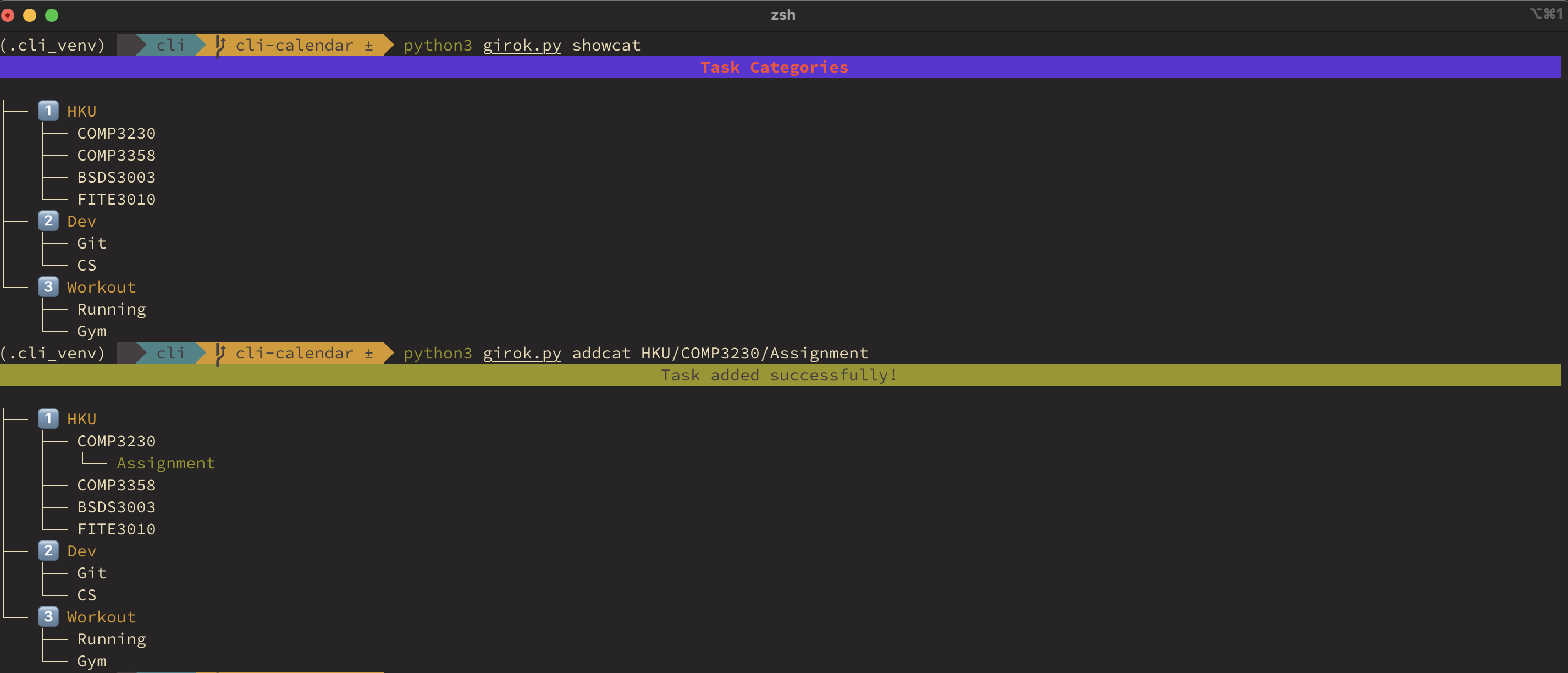
Remove Categories
You could also remove a category by specifying a target path. Notice that all subcategories are recursively removed. 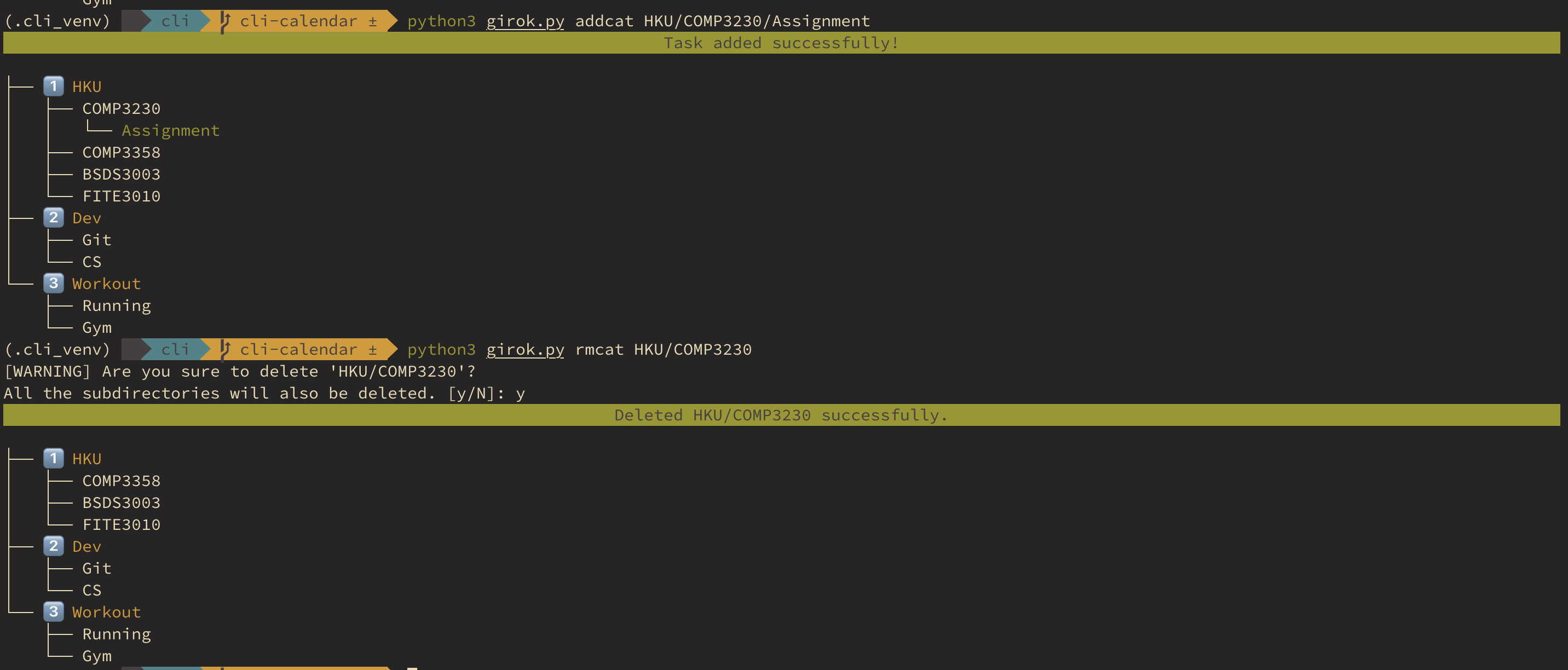
Move Category
Lastly, you can move a category into another category. Notice that all subcategories are also recursively moved. 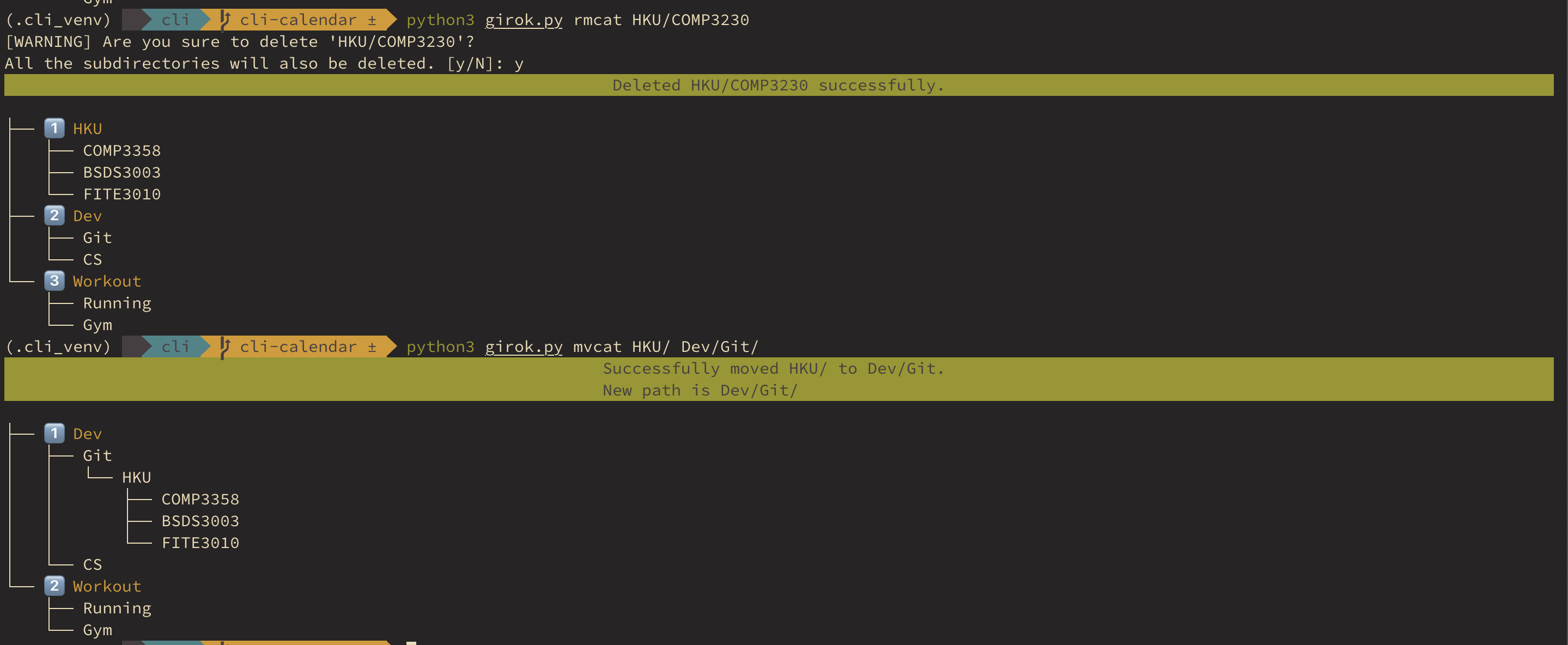
Modeling self-referential relationship
Let’s first define a category table named task_category with SQLAlchemy.
To efficiently model the hierarchical structure, we use a self-referential table which means a table has a foreign key referencing a key of its table itself.
For our case, each category could possibly have the infinite number of children. Hence, this is a one-to-many relationship.
In SQLAlchemy, the representation of this tree structure can be done with relationship().
Here, I named super_task_category_id as a foreign key pointing to the parent table.
Then, define relationship(). The parameter is the table name (not the actual name but the class). Notice I added cascade="all,delete" so that I can remove the whole tree recursively
[Warning] In SQLAlchemy, relationship(), by default, behaves as the one-to-many relationship whether it’s one-to-many or many-to-one.
To build a many-to-one relationship, we need an extra directive relationship.remote_side
Both directions can be combined into a bidirectional relationship with backref().
Notice that the entry has NULL parent is the top most category.
Visualize tree with Rich library
Now, let’s visualize the tree with Rich library. Rich offers a powerful tool for building CLI apps.
Create category
To create a new category, let’s accept a full target category path delimited by /, with the new category name as the last item. For example, girok addcat HKU/COMP3230 will create a new category named COMP3230 under HKU category.
To add it under HKU category, we need to check two things.
- There exists a category named
HKU - There does not exist a category named
COMP3230underHKU
Our create category router accepts a request body named category. Here, category['names'] is a list of category names including the new category name.
To check the first condition, we’ll try to obtain the id of the second last category and check if it’s possible (If not, then there must be a missing category).
I created a function named get_last_cat_id which accepts cats which is a list of categories and returns the id of the last category.
First initialize the parent_id = None since the topmost category has a NULL parent. Then, iterate through the list and get the id of each element with get_category_id_by_name_and_parent_id() function which returns None if there’s no match. Hence, if there’s no matching category, raise SubcategoryNotExistException. If there’s a match, then update parent_id = cat_id.
In this way, we can check the first condition.
Suppose our target path is HKU/COMP3230/Assignment. Then, now we know that the second last item of the category list COMP3230 is a valid category. However, we have to make sure that there does not already exist a Assignment category under HKU/COMP3230. This can be easily with get_category_id_by_name_and_parent_id() function we used earlier.
We’ve already obtained the id of the COMP3230 category. Now, extract the last category from the list (which is the new category name). Check if there already exists a category named Assignment under the COMP3230. If so, raise CategoryAlreadyExistException
After successfully passing the two constraints, let’s now add a Assignment under HKU/COMP3230.
All we have to do is create a category whose super_task_category_id is equal to the pid_of_second_last_cat, constructing a parent-child relationship.
Remove category
Now, let’s also remove a category by accepting a full target category path such as HKU/COMP3230/Assignment. In this example, we’re trying to delete a category named Assignment under HKU/COMP3230.
It’s much simpler than creating a category since we already made athe reusable get_last_cat_id() function.
When deleting a category, all we need to check is that there exists a category named Assignment under HKU/COMP3230. Hence, we pass the category list to get_last_cat_id() function to get the id of COMP3230. If if throws an exception, then it means there is a missing category along HKU/COMP3230 path.
After getting the last category id, we can easily delete it.
Move Category
We also should handle moving a category from one place to another.
For example,
Suppose we want to move the entire category HKU (and its recursive subcategories) into under Dev/Git category.
To achive that, we can simply changing the parent of HKU to Git. However, we need to first check a number of constraints.
- You cannot move a root directory
/. - The source category
HKUand the target directoryDev/Gitmust exist - The target directory
Dev/Git/must contain the category nameHKU.
To check the first condition, we can simply check whether the input source category path is an empty list or not.
For the second condition, we can use get_last_cat_id() function.
For the last condition, we can use the get_category_id_by_name_and_parent_id() function. 
Visualize category tree with Rich
Now, we want to visualize the category tree. I’m going to use Rich library which is an amazing tool for building CLI applications.
Let’s first look at the server.
Our server will return all the categories as a dictionary like below.
First, let’s get all topmost categories. 
Then, iterate each category and recursively build a category tree with build_category_tree() function. 
 In
In build_category_tree function, we first get all sub-category ids. Then, iterate each sub-category and recursively attach the subcategory tree.
build_category_tree function returns output in the form of the following.
1
2
3
4
5
6
7
8
9
10
11
{
"Category1": {
"color": "yellow",
"subcategories": {...}
},
"Category2": {
"color": "yellow",
"subcategories": {...}
},
...
}
Rich offers a tree so that you can more easily build a tree structure in terminal.
Below are the basic steps to visualize a tree.
Now, the CLI will receive this response and store into cats_dict and pass it to display_categories function to nicely visualize tree.
The above is an example of Typer library to build CLI apps.
display_categories function accepts the cats_dict and iterate each key (which is the category name) and call display_category function, passing category name cat, and the tree object tree.
Keep in mind that the tree.add() method returns the created sub-tree object.
In display_category function, tree parameter refers to the parent tree object of the tree object of the current call stack.
Hence, we add the current category to the parent tree object.
Then, we iterate the sub-categories of the current category and recursively build the subtree.
Finally, we print the tree object with console.print()
Conclusion
So far, we’ve seen how to design a self-referential table to models infinite category tree. Also, we learned how to perform different operations with FastAPI, SQLAlchemy, Typer, and Rich.
In the following posts, I’ll explore how to add tasks which are assigned to a specific category like below. 
Also, I’ll make a post about creating a beautiful CLI app, integrating the category tree we’ve discussed so far.
Thank you for reading!





